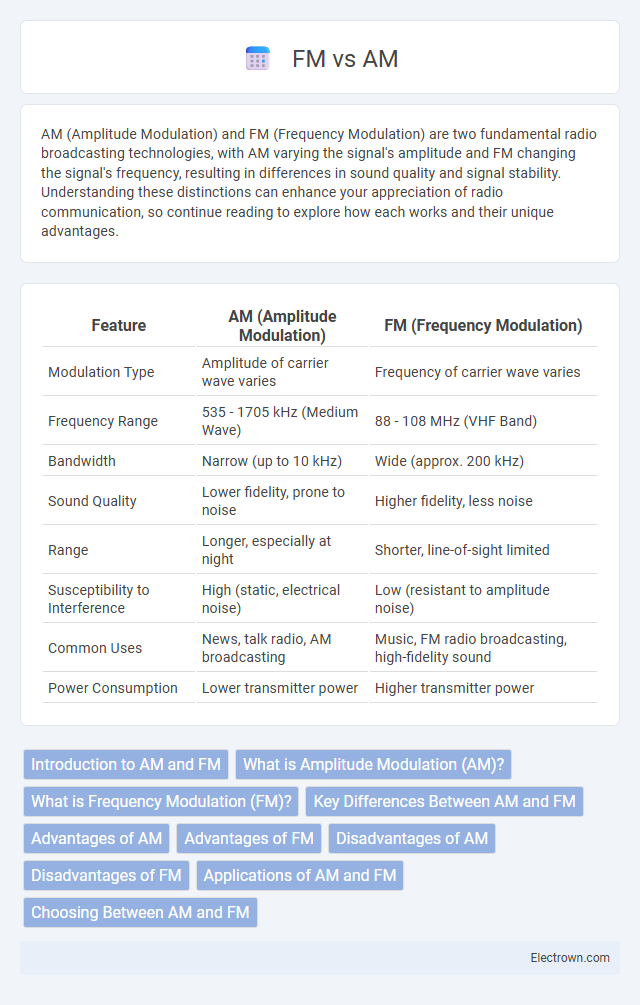AM (Amplitude Modulation) and FM (Frequency Modulation) are two fundamental radio broadcasting technologies, with AM varying the signal's amplitude and FM changing the signal's frequency, resulting in differences in sound quality and signal stability. Understanding these distinctions can enhance your appreciation of radio communication, so continue reading to explore how each works and their unique advantages.
Table of Comparison
| Feature | AM (Amplitude Modulation) | FM (Frequency Modulation) |
|---|---|---|
| Modulation Type | Amplitude of carrier wave varies | Frequency of carrier wave varies |
| Frequency Range | 535 - 1705 kHz (Medium Wave) | 88 - 108 MHz (VHF Band) |
| Bandwidth | Narrow (up to 10 kHz) | Wide (approx. 200 kHz) |
| Sound Quality | Lower fidelity, prone to noise | Higher fidelity, less noise |
| Range | Longer, especially at night | Shorter, line-of-sight limited |
| Susceptibility to Interference | High (static, electrical noise) | Low (resistant to amplitude noise) |
| Common Uses | News, talk radio, AM broadcasting | Music, FM radio broadcasting, high-fidelity sound |
| Power Consumption | Lower transmitter power | Higher transmitter power |
Introduction to AM and FM
AM (Amplitude Modulation) and FM (Frequency Modulation) are two primary radio broadcasting technologies that transmit audio signals by varying amplitude and frequency, respectively. AM radio operates within the medium frequency band, typically 530 to 1700 kHz, offering longer range but lower sound quality, whereas FM radio functions in the very high frequency band, usually 88 to 108 MHz, providing superior audio clarity and reduced interference. Your choice between AM and FM depends on the need for either broader coverage or higher fidelity sound in radio communication.
What is Amplitude Modulation (AM)?
Amplitude Modulation (AM) is a technique used in electronic communication where the amplitude of a carrier wave is varied in proportion to the message signal, while the frequency remains constant. AM is widely used in radio broadcasting, enabling transmission over long distances with relatively simple receiver designs. Your understanding of AM allows for better insight into how audio signals are transmitted and received in various communication systems.
What is Frequency Modulation (FM)?
Frequency Modulation (FM) is a method of encoding information in a carrier wave by varying its instantaneous frequency according to the amplitude of the input signal. FM provides improved noise resistance and higher sound quality compared to Amplitude Modulation (AM) by maintaining a constant amplitude, making it ideal for music and voice transmissions. Widely used in radio broadcasting, FM typically operates in the VHF frequency range of 88 to 108 MHz, delivering clear audio signals with minimal interference.
Key Differences Between AM and FM
AM (Amplitude Modulation) transmits signals by varying the amplitude of the carrier wave, making it more susceptible to noise and interference, whereas FM (Frequency Modulation) changes the frequency of the carrier wave, providing better sound quality and resistance to signal degradation. FM typically operates within the 88 to 108 MHz frequency band, offering higher fidelity sound ideal for music, while AM spans 535 to 1705 kHz, often used for talk radio due to its longer transmission range. Understanding these key differences helps you choose the best broadcasting method based on your needs for audio clarity or coverage area.
Advantages of AM
AM radio offers extensive coverage, especially in rural and remote areas, due to its ability to travel long distances and penetrate obstacles. The technology is simpler and more cost-effective, making AM broadcasting accessible for local stations and emergency communications. Your access to AM ensures reliable transmission during power outages or severe weather, enhancing public safety and information dissemination.
Advantages of FM
FM (Frequency Modulation) offers superior sound quality compared to AM due to its higher resistance to noise and interference, making it ideal for music broadcasting. The wider bandwidth of FM allows for better fidelity and stereo sound, enhancing listener experience. FM signals also have a shorter range but provide consistent reception in urban environments with reduced signal fading.
Disadvantages of AM
AM radio signals are more susceptible to electrical interference from devices like power lines and storms, which can cause static and reduce audio clarity. The limited bandwidth of AM results in lower sound quality, making it less suitable for music compared to FM's wider bandwidth and higher fidelity. Your listening experience may suffer due to AM's poor resistance to signal fading, especially in urban environments with many obstacles.
Disadvantages of FM
FM (Frequency Modulation) signals have a limited range compared to AM (Amplitude Modulation) signals due to their higher frequency, which results in reduced geographical coverage. FM is more susceptible to physical obstructions like buildings, hills, and mountains, causing signal degradation in urban or hilly areas. Additionally, FM broadcasting requires more complex and costly transmission equipment and higher bandwidth, which limits channel availability.
Applications of AM and FM
AM radio technology is widely used in broadcasting for talk radio, news, and emergency communication due to its long-range signal capabilities, especially in rural areas. FM radio excels in music broadcasting with superior sound quality and resistance to static, making it ideal for urban and suburban environments. You can rely on AM for extensive coverage and FM for clear, high-fidelity audio in your daily listening preferences.
Choosing Between AM and FM
Choosing between AM and FM radio depends on the desired audio quality and broadcast range. FM provides superior sound clarity and is less susceptible to interference, making it ideal for music and local broadcasts, while AM offers greater coverage area, which suits talk radio and news in rural regions. Considering factors such as terrain, audience location, and content type helps determine the optimal frequency modulation for a specific broadcasting need.
AM vs FM Infographic

 electrown.com
electrown.com